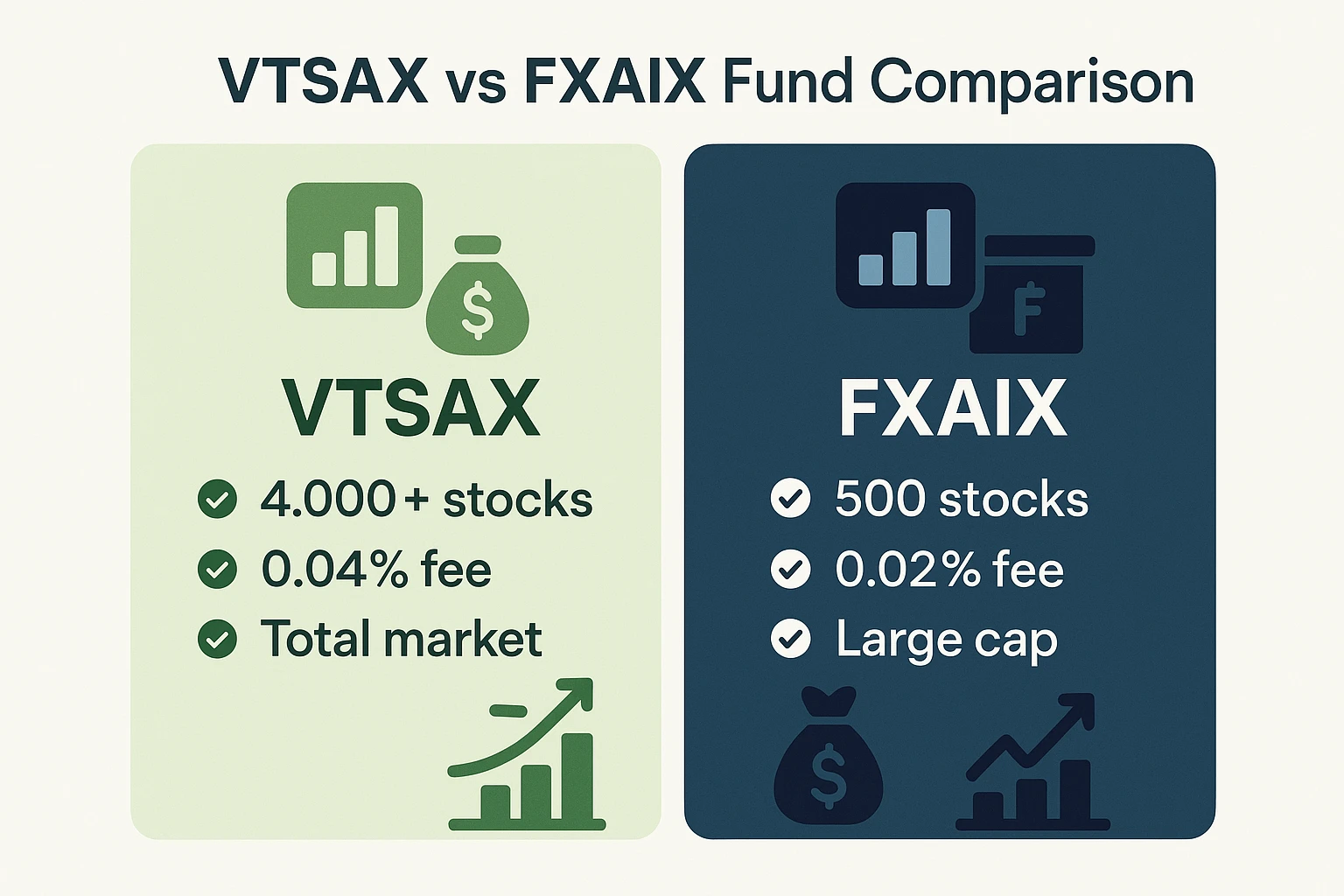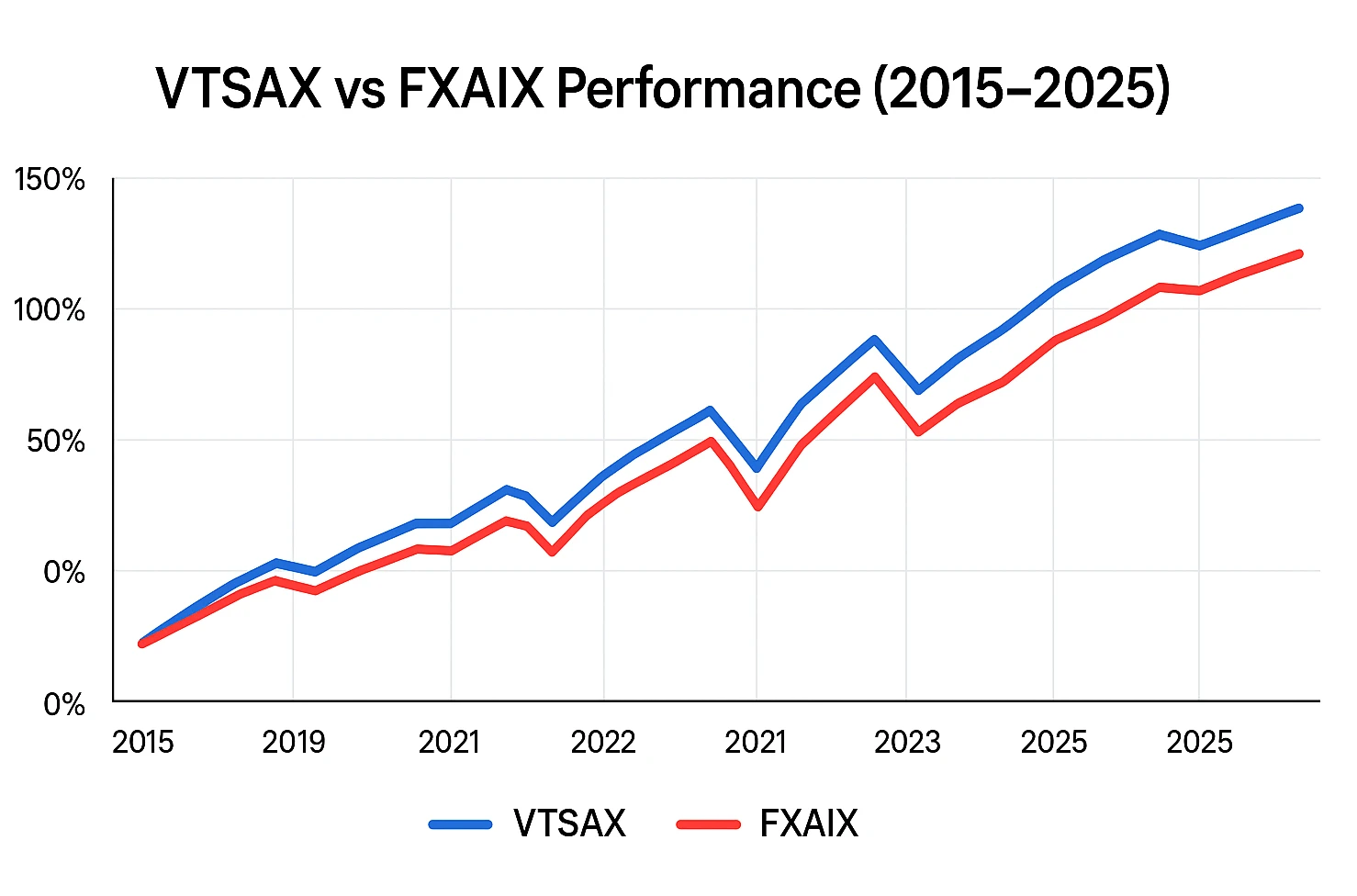
Feeling lost picking an index fund? Trust me, I’ve been there. Deciding between VTSAX vs FXAIX can feel like a big money showdown. Index funds are awesome for folks like us who want to grow our savings over time without crazy fees or stress, perfect for anyone learning how to be frugal in 2025. So, let’s unpack the differences between Vanguard’s VTSAX (Vanguard Total Stock Market Index Fund Admiral Shares) and Fidelity’s FXAIX (Fidelity 500 Index Fund). They’re both top-notch, but each has its own vibe. Ready to figure out which one’s your best bet for 2025? Let’s jump into the face-off! 🥊
Table of Contents
Key Takeaways at a Glance
- VTSAX casts a wider net: It grabs ~4,000 U.S. stocks, from big names to tiny startups. Meanwhile, FXAIX sticks to the 500 biggest in the S&P 500. 🌍
- Both are dirt-cheap: VTSAX and FXAIX keep fees super low, around 0.04% or less, so your money grows more. 💰
- Performance swings with markets: FXAIX might pull ahead when big companies shine, but VTSAX can win when smaller stocks rally. 📈
- VTSAX saves on taxes: Its ETF version (VTI) cuts down capital gains in taxable accounts compared to FXAIX. 💼
- It’s about your style: Go for VTSAX if you want the whole U.S. market, or FXAIX if you love big, stable companies. Both rock. ✅
Why Index Funds Matter: A Quick Primer
Before we dig into the comparison, let’s talk about why index funds are such a big deal. Basically, they follow a market index, like the S&P 500, to match its performance without trying to outsmart it. For instance, FXAIX holds shares in 500 major U.S. companies, giving you a piece of the action. Pairing them with free financial tools every saver should use can keep your budget on track.
Here’s why I love index funds:
- Spread the risk: Your money’s split across tons of stocks, so one company’s flop won’t ruin you.
- Low fees: No pricey research teams mean cheaper costs than active funds.
- Easy peasy: No need to study individual stocks—just buy the market.
- Built for the long haul: Over decades, indexes tend to grow steadily, perfect for retirement.
Now that we’re on the same page, let’s meet the stars of this showdown.

Introducing VTSAX and FXAIX
VTSAX: Vanguard Total Stock Market Index Fund
VTSAX, from Vanguard, tracks the CRSP US Total Market Index. It owns over ~4,000 stocks—big, medium, and small—covering nearly every U.S. company out there.
- What it holds: ~99.5% of U.S. stock market value.
- Minimum to start: $3,000 for Admiral Shares.
- Unofficial motto: “Grab the whole haystack.”
Vanguard, started by John Bogle, is all about keeping costs low for investors like us, making VTSAX a go-to for diversification lovers.
FXAIX: Fidelity 500 Index Fund
FXAIX, from Fidelity, follows the S&P 500, holding 500 of the biggest U.S. companies like Apple and Microsoft. So, it’s perfect if you want to bet on the heavy hitters.
- What it holds: ~500 large-cap U.S. companies.
- Minimum to start: $0, great for newbies.
- Unofficial motto: “Bet on America’s giants.”
Fidelity’s low fees and easy-to-use platform make FXAIX a super approachable choice.
VTSAX vs FXAIX: Head-to-Head Comparison
Expense Ratios: Why Fees Matter
Expense ratios are the yearly fees you pay, and even tiny differences can add up over time. Here’s the breakdown:
- VTSAX: 0.04% ($4 per $10,000).
- FXAIX: 0.015% ($1.50 per $10,000).
FXAIX is slightly cheaper, but both are so affordable that other factors often tip the choice between these funds.
Minimum Investments: Accessibility
Getting started looks different:
- VTSAX: Needs $3,000 for Admiral Shares.
- FXAIX: $0, perfect for starting small.
If $3,000 is steep, Vanguard’s VTI (the ETF version of VTSAX) costs ~$200–$400 per share.
Diversification: What Each Holds
The big difference between the two is what they cover:
- VTSAX: The whole U.S. market—big, medium, and small stocks.
- FXAIX: S&P 500, ~80% of market value, just big companies.
VTSAX is like buying the entire stock market; FXAIX sticks to the big dogs.
Sector Allocations: Under the Hood
Both lean heavy on tech and finance, but VTSAX gets a bit more action in industrials and healthcare thanks to smaller companies. Want specifics? Check Morningstar for the latest breakdowns.
Historical Performance: Long-Run Returns
How they perform depends on the market (check Vanguard/Fidelity for current numbers):
| Fund | 1-Year Return | 5-Year Return (Avg. Ann.) | 10-Year Return (Avg. Ann.) |
|---|---|---|---|
| VTSAX | ~25.2% | ~15.2% | ~12.2% |
| FXAIX | ~26.2% | ~15.2% | ~13.2% |
Note: FXAIX often leads when big companies dominate, but VTSAX can pull ahead in small-cap surges.
Dividend Yields: Income Potential
Both pay quarterly dividends:
- VTSAX: ~1.3% yield.
- FXAIX: ~1.35% yield.
Reinvest those dividends, and you’ll see your returns grow.
Tax Efficiency in Taxable Accounts
In taxable accounts, VTSAX (or VTI) saves you money by cutting capital gains taxes, thanks to Vanguard’s ETF setup. FXAIX is decent but might hit you with small tax bills. In IRAs or 401(k)s, taxes aren’t a worry, so it’s a toss-up.

A Real Investor’s Story: Choosing Between the Funds
Her choice shows how your goals steer the decision.
Platform Comparison: Vanguard vs Fidelity
Usability and Customer Service
Fidelity’s slick website and responsive support are great if you love a modern vibe. Vanguard’s simpler platform works for set-it-and-forget-it investors but can feel a bit clunky.
Investment Philosophy
Vanguard is all about low fees and investor ownership. Fidelity offers active and passive choices across IRAs, 401(k)s, and 529s.
Interactive Comparison Tool: VTSAX vs FXAIX
Want to see how the two options stack up for you? Play with this tool to find your match.
| Fund | Expense Ratio | Minimum Investment | 1-Year Return | 5-Year Return | Asset Allocation | Suitability |
|---|
💡 Tip:
Switch the account type to find the best fund for your goals.
Who Should Choose Which Fund?
So, who wins in this debate? It’s all about what you’re aiming for. Let’s break it down.
VTSAX: Best for Broad Market Fans
VTSAX is your pick if you want to own a slice of every U.S. stock out there.
- You’re into small and mid-cap stocks for extra growth potential.
- You want to keep taxes low in a taxable account.
- You’re cool with the $3,000 minimum or prefer VTI.
FXAIX: Ideal for Large-Cap Focus
FXAIX is great if you trust the big, stable companies to lead the way.
- You want to stick with major players like Apple.
- You’re starting small with $0 minimum.
- You’re investing in IRAs where taxes don’t matter.
Beginners: Where to Start
Beginners often like FXAIX’s $0 minimum to get started. If you’ve got a bit more saved, VTI gives you VTSAX’s broad coverage on a budget.

Glossary: Key Terms Explained
- Expense Ratio: The yearly fee you pay, based on your investment size.
- Capital Gains Distributions: Taxable profits from fund sales in taxable accounts.
- Index Fund: A fund that tracks a market index for cheap, diversified investing.
Frequently Asked Questions
Your Decision: VTSAX vs FXAIX in 2025
Both VTSAX and FXAIX are solid paths to broad U.S. stock market exposure. Here’s the quick rundown:
- Choose VTSAX: For full market coverage, tax efficiency in taxable accounts, or if you prefer Vanguard.
- Choose FXAIX: For large-cap focus, $0 minimums, or if you prefer Fidelity.
Keep investing regularly, and whether you go with VTSAX or FXAIX, you’re setting up a solid future. Combine it with smart budgeting habits to maximize your savings in 2025. 🚀
Affiliate Disclosure: This article may contain links to companies. If you open an account through these links, we may receive a commission at no extra cost to you.
This content is for informational purposes only and not financial advice. The author is not a financial advisor; consult a qualified professional before making investment decisions.

